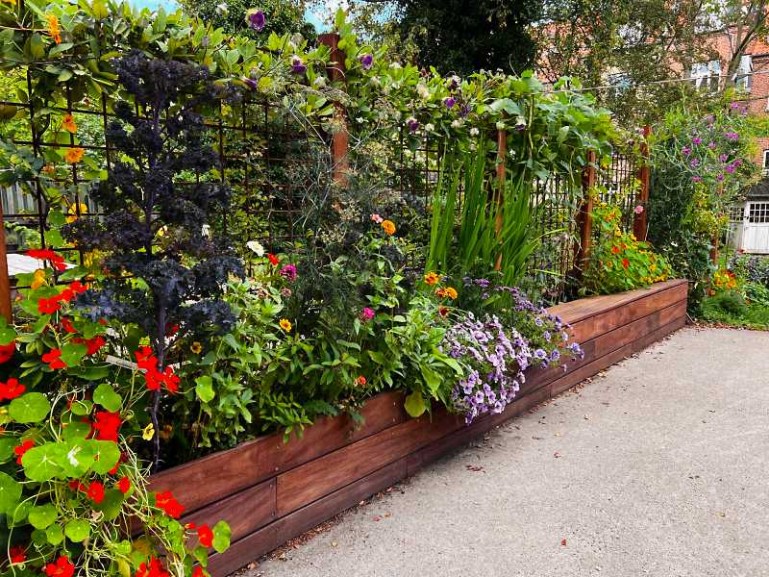Link(s) :


22.09.2023
Interholco asked eco-designer Kristian Jørgensen about the benefits of tali. To see the article in pictures, visit the Interholco website.

Is the forecast predicting rough weather at your end? Then brace yourself: stark temperature drops, high winds and heavy rain can sometimes cause damage. When a winter storm thrashed his backyard wall in Aarhus, Denmark, eco-techie Kristian Jørgensen knew what to do. He wielded his wood magic on the deteriorated cement.
A bright, reddish-brown Tali fence was DIYed on top of the old cement, avoiding demolition. Except this new fence eliminated the need for tall view-stoppers that are traditionally seen in shared spaces.
Result: an idyllic ‘friendly fence’ project, made up of flowerpots and a large mesh net, inviting plants to grow. Every now and then, benches on each side, also with the peach-pearlish brown of Tali wood cladding. ‘On sunny days, one of our neighbours has her lunch on the benches,’ says Kristian. ‘That makes me forget all about the harsh weather during the build and all the broken drills!’
Why was Tali chosen for this application?
KJ: We chose tropical timber due to aesthetics and natural durability. FSC-certified Tali, Cumaru, and Piquia were selected in dialogue with Global Timber. The project primarily relies on Tali wood species, used for the cladding of the fence.
What challenges did the outdoor fence pose?
KJ: Limited economic expenses and quality materials with a focus on environmental performance were essential factors. It was not only the price that was an issue, but also the footprint involved with the demolition of deteriorated cement, casting new one, and using iron. The previous solution of pressure-treated boards also did not appeal to us. We ended up building the fence on top of the existing deteriorated cement, avoiding demolition.
What can you say about the sourcing of the Tali wood?
KJ: The boards used for the cladding came in short lengths of 155cm, which also has its sustainable advantages. Building with short boards limits waste as defective boards can be sorted out and shortened into regular products, limiting waste in the build.
Anything to say about the installation process?
KJ: The most resource-intensive aspect was building it ourselves, but there was also a sense of community around that. Luckily one of the residents is an architect and constructor and the professional drawings and material calculations gave a very precise estimate of materials. The volume of timber was spot on. Boards were all pre-drilled and in total 700 screws were used - less could have done the trick. At the end, a transparent oil was applied to the fence surfaces.
Can you say more about the location of this fence?
KJ : The fence is 10 meter long, stretching East to West, with North/South exposure. The difference between the winter-facing (North) and sunny (South) side has not been much of a problem. Most of our focus was on securing the right species to cope with ground contact in the flower boxes. Whether we will maintain annual or bi-annual oiling is not yet decided. The fence could also turn all grey and rely on natural durability.
What other factors were considered in selecting this species?
KJ: I find it hard not to fall in love with Tali. Tali is a lesser-used timber species in many markets, but it possesses functional and aesthetic qualities that are fully competitive with species such as Sapelli and Jatoba. Piquia - not to be confused with its close relative Piquiarana, which is less durable - has an oak-like appearance and is often sold simply as hardwood joists. Piquia, too, is reliable even when in contact with the ground. The quality of Cumaru garden posts is no stranger to the market. Of course, timber had to be FSC certified and that should always be the answer.
Any specs you can provide about this wood or possibly comparisons with other species that were considered?
KJ: Tali was specifically chosen because it is relatively prevalent in several FSC-certified forests in the Congo Basin. Also, it is high on the list of species the region aims to promote to take away some pressure from the ‘usual suspects’, i.e. widely known tropical timber species which are much more frequently used.
Any feedback from people (including neighbours!) about the Tali cladding?
KJ: The building process was a bit long, as this was a side project, done in the evenings and on weekends. The mess was forgiven instantly and so far the fence has turned out as hoped: with a lot of talk through it about watering, plants and if we should consider a similar project to the other side of the yard.
Link(s) :